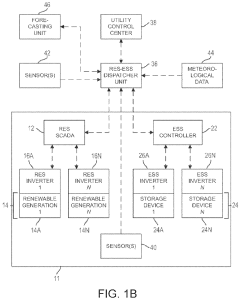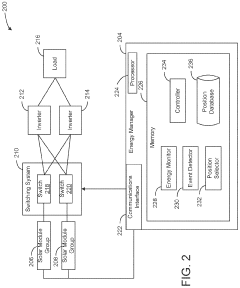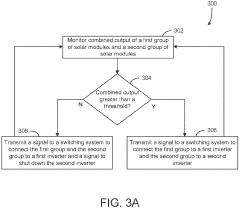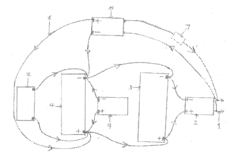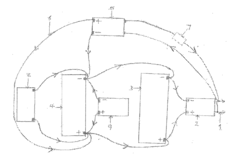How to Leverage Solar Inverters for Energy Independence?
JUL 17, 20259 MIN READ
Generate Your Research Report Instantly with AI Agent
Patsnap Eureka helps you evaluate technical feasibility & market potential.
Solar Inverter Evolution and Objectives
Solar inverter technology has undergone significant evolution since its inception in the 1990s. Initially designed to convert DC power from solar panels into AC power for grid use, these devices have transformed into sophisticated energy management systems. The primary objective of solar inverters has shifted from simple power conversion to enabling energy independence and grid stability.
The evolution of solar inverters can be traced through several key stages. Early models were basic string inverters, capable of handling a single array of solar panels. As the technology progressed, microinverters emerged, allowing for panel-level optimization and improved system efficiency. The next major advancement came with the introduction of hybrid inverters, which integrated battery storage capabilities, marking a significant step towards energy independence.
Current objectives for solar inverter technology focus on enhancing grid integration, improving energy efficiency, and increasing system reliability. Advanced features such as reactive power control, voltage regulation, and frequency response are being incorporated to support grid stability. Additionally, there is a growing emphasis on developing smart inverters with communication capabilities, enabling seamless integration with home energy management systems and smart grids.
The pursuit of energy independence has become a central goal in solar inverter development. This objective involves creating systems that can operate autonomously, manage energy flow between solar panels, batteries, and the grid, and optimize energy consumption based on user preferences and electricity pricing. Inverters are now expected to handle bidirectional power flow, allowing for both energy export to the grid and energy import during off-peak hours.
Another key objective is to improve the resilience of solar power systems. This includes developing inverters with islanding capabilities, enabling them to continue operating during grid outages and providing backup power to critical loads. The integration of artificial intelligence and machine learning algorithms is also being explored to predict energy generation and consumption patterns, further optimizing system performance.
As the solar industry moves towards higher voltage systems, inverter manufacturers are focusing on developing products that can handle 1500V DC input, increasing overall system efficiency and reducing balance of system costs. Simultaneously, efforts are being made to reduce the size and weight of inverters while improving their durability and lifespan.
In conclusion, the evolution of solar inverters reflects a broader shift in the energy landscape towards decentralized, renewable power generation. The objectives driving this evolution are centered on achieving greater energy independence, enhancing grid support capabilities, and improving overall system efficiency and reliability. As technology continues to advance, solar inverters are poised to play an increasingly critical role in the transition to a sustainable energy future.
The evolution of solar inverters can be traced through several key stages. Early models were basic string inverters, capable of handling a single array of solar panels. As the technology progressed, microinverters emerged, allowing for panel-level optimization and improved system efficiency. The next major advancement came with the introduction of hybrid inverters, which integrated battery storage capabilities, marking a significant step towards energy independence.
Current objectives for solar inverter technology focus on enhancing grid integration, improving energy efficiency, and increasing system reliability. Advanced features such as reactive power control, voltage regulation, and frequency response are being incorporated to support grid stability. Additionally, there is a growing emphasis on developing smart inverters with communication capabilities, enabling seamless integration with home energy management systems and smart grids.
The pursuit of energy independence has become a central goal in solar inverter development. This objective involves creating systems that can operate autonomously, manage energy flow between solar panels, batteries, and the grid, and optimize energy consumption based on user preferences and electricity pricing. Inverters are now expected to handle bidirectional power flow, allowing for both energy export to the grid and energy import during off-peak hours.
Another key objective is to improve the resilience of solar power systems. This includes developing inverters with islanding capabilities, enabling them to continue operating during grid outages and providing backup power to critical loads. The integration of artificial intelligence and machine learning algorithms is also being explored to predict energy generation and consumption patterns, further optimizing system performance.
As the solar industry moves towards higher voltage systems, inverter manufacturers are focusing on developing products that can handle 1500V DC input, increasing overall system efficiency and reducing balance of system costs. Simultaneously, efforts are being made to reduce the size and weight of inverters while improving their durability and lifespan.
In conclusion, the evolution of solar inverters reflects a broader shift in the energy landscape towards decentralized, renewable power generation. The objectives driving this evolution are centered on achieving greater energy independence, enhancing grid support capabilities, and improving overall system efficiency and reliability. As technology continues to advance, solar inverters are poised to play an increasingly critical role in the transition to a sustainable energy future.
Energy Independence Market Analysis
The energy independence market, driven by the increasing adoption of solar inverters, is experiencing significant growth and transformation. This market is characterized by a growing demand for sustainable energy solutions that reduce reliance on traditional power grids and fossil fuels. Solar inverters play a crucial role in this market by converting direct current (DC) from solar panels into alternating current (AC) for use in homes and businesses, as well as enabling grid interaction.
The global solar inverter market size was valued at $12.9 billion in 2021 and is projected to reach $26.3 billion by 2030, growing at a CAGR of 8.1% from 2022 to 2030. This growth is primarily fueled by increasing awareness of climate change, government incentives for renewable energy adoption, and the declining costs of solar technology. The residential sector is expected to witness the highest growth rate due to rising energy costs and the desire for energy independence among homeowners.
Key market drivers include technological advancements in solar inverter efficiency, integration of smart features for better energy management, and the development of hybrid inverters that can work with both solar panels and battery storage systems. The latter is particularly important for achieving true energy independence, as it allows for power generation and storage for use during non-sunlight hours or grid outages.
Geographically, Asia-Pacific dominates the solar inverter market, with China and India leading in both production and consumption. Europe follows closely, driven by ambitious renewable energy targets and supportive policies. North America, particularly the United States, is also experiencing rapid growth in the solar inverter market, spurred by federal tax incentives and state-level renewable portfolio standards.
The energy independence market is not limited to solar inverters alone but encompasses a broader ecosystem of renewable energy technologies, energy storage solutions, and smart grid systems. This holistic approach to energy independence is creating new opportunities for market players to offer integrated solutions that combine solar generation, storage, and intelligent energy management.
Challenges in the market include the need for significant upfront investment, variability in solar energy production, and the complexity of integrating renewable energy sources into existing grid infrastructure. However, ongoing technological improvements and supportive policies are gradually addressing these barriers, paving the way for wider adoption of solar inverters and energy independence solutions.
The global solar inverter market size was valued at $12.9 billion in 2021 and is projected to reach $26.3 billion by 2030, growing at a CAGR of 8.1% from 2022 to 2030. This growth is primarily fueled by increasing awareness of climate change, government incentives for renewable energy adoption, and the declining costs of solar technology. The residential sector is expected to witness the highest growth rate due to rising energy costs and the desire for energy independence among homeowners.
Key market drivers include technological advancements in solar inverter efficiency, integration of smart features for better energy management, and the development of hybrid inverters that can work with both solar panels and battery storage systems. The latter is particularly important for achieving true energy independence, as it allows for power generation and storage for use during non-sunlight hours or grid outages.
Geographically, Asia-Pacific dominates the solar inverter market, with China and India leading in both production and consumption. Europe follows closely, driven by ambitious renewable energy targets and supportive policies. North America, particularly the United States, is also experiencing rapid growth in the solar inverter market, spurred by federal tax incentives and state-level renewable portfolio standards.
The energy independence market is not limited to solar inverters alone but encompasses a broader ecosystem of renewable energy technologies, energy storage solutions, and smart grid systems. This holistic approach to energy independence is creating new opportunities for market players to offer integrated solutions that combine solar generation, storage, and intelligent energy management.
Challenges in the market include the need for significant upfront investment, variability in solar energy production, and the complexity of integrating renewable energy sources into existing grid infrastructure. However, ongoing technological improvements and supportive policies are gradually addressing these barriers, paving the way for wider adoption of solar inverters and energy independence solutions.
Solar Inverter Technology Landscape
Solar inverter technology has undergone significant advancements in recent years, playing a crucial role in the transition towards renewable energy and energy independence. The landscape of solar inverter technology is characterized by continuous innovation, driven by the increasing demand for more efficient, reliable, and intelligent power conversion systems.
At the core of solar inverter technology are power electronics and control systems that convert direct current (DC) from solar panels into alternating current (AC) suitable for grid connection or local consumption. Modern inverters have evolved from simple power conversion devices to sophisticated energy management systems, incorporating features such as maximum power point tracking (MPPT), grid support functions, and advanced monitoring capabilities.
The current solar inverter market is dominated by three main types: string inverters, microinverters, and power optimizers. String inverters, the most common type, connect multiple solar panels in series and convert their combined DC output to AC. Microinverters, on the other hand, are attached to individual solar panels, offering panel-level conversion and monitoring. Power optimizers represent a hybrid approach, combining some benefits of both string inverters and microinverters.
Recent technological trends in solar inverters include the integration of energy storage solutions, enabling greater energy independence and grid resilience. Hybrid inverters, capable of managing both solar power and battery storage, are gaining popularity in residential and commercial applications. These systems allow for intelligent energy management, storing excess solar energy for use during peak demand periods or grid outages.
Another significant development is the incorporation of smart grid functionalities. Modern inverters can communicate with the grid, adjusting their output to maintain grid stability and power quality. This bi-directional communication enables features such as reactive power control, voltage regulation, and frequency response, making solar systems more grid-friendly and valuable to utilities.
The push for higher efficiency has led to the development of wide-bandgap semiconductor materials, such as silicon carbide (SiC) and gallium nitride (GaN), in inverter designs. These materials allow for higher switching frequencies, reduced losses, and improved thermal performance, resulting in more compact and efficient inverters.
As the solar industry continues to grow, inverter manufacturers are focusing on enhancing reliability and longevity. Advanced diagnostic capabilities, self-healing algorithms, and robust design practices are being implemented to extend the operational life of inverters and reduce maintenance requirements. This focus on reliability is crucial for ensuring the long-term viability of solar energy systems and maximizing return on investment for system owners.
At the core of solar inverter technology are power electronics and control systems that convert direct current (DC) from solar panels into alternating current (AC) suitable for grid connection or local consumption. Modern inverters have evolved from simple power conversion devices to sophisticated energy management systems, incorporating features such as maximum power point tracking (MPPT), grid support functions, and advanced monitoring capabilities.
The current solar inverter market is dominated by three main types: string inverters, microinverters, and power optimizers. String inverters, the most common type, connect multiple solar panels in series and convert their combined DC output to AC. Microinverters, on the other hand, are attached to individual solar panels, offering panel-level conversion and monitoring. Power optimizers represent a hybrid approach, combining some benefits of both string inverters and microinverters.
Recent technological trends in solar inverters include the integration of energy storage solutions, enabling greater energy independence and grid resilience. Hybrid inverters, capable of managing both solar power and battery storage, are gaining popularity in residential and commercial applications. These systems allow for intelligent energy management, storing excess solar energy for use during peak demand periods or grid outages.
Another significant development is the incorporation of smart grid functionalities. Modern inverters can communicate with the grid, adjusting their output to maintain grid stability and power quality. This bi-directional communication enables features such as reactive power control, voltage regulation, and frequency response, making solar systems more grid-friendly and valuable to utilities.
The push for higher efficiency has led to the development of wide-bandgap semiconductor materials, such as silicon carbide (SiC) and gallium nitride (GaN), in inverter designs. These materials allow for higher switching frequencies, reduced losses, and improved thermal performance, resulting in more compact and efficient inverters.
As the solar industry continues to grow, inverter manufacturers are focusing on enhancing reliability and longevity. Advanced diagnostic capabilities, self-healing algorithms, and robust design practices are being implemented to extend the operational life of inverters and reduce maintenance requirements. This focus on reliability is crucial for ensuring the long-term viability of solar energy systems and maximizing return on investment for system owners.
Current Solar Inverter Solutions
01 Grid-independent solar inverter systems
Solar inverter systems designed for energy independence, capable of operating without reliance on the main power grid. These systems often incorporate energy storage solutions and intelligent power management to ensure continuous power supply even during periods of low solar generation.- Grid-independent solar inverter systems: Solar inverter systems designed for energy independence, capable of operating without reliance on the main power grid. These systems often incorporate energy storage solutions and advanced control mechanisms to manage power flow and ensure continuous electricity supply.
- Hybrid solar inverters with battery integration: Inverters that combine solar power generation with battery storage capabilities, allowing for increased energy independence. These systems can store excess solar energy for use during non-sunlight hours or grid outages, enhancing overall system efficiency and reliability.
- Smart energy management for solar inverters: Intelligent control systems and algorithms for solar inverters that optimize energy production, consumption, and storage. These technologies enable better load balancing, peak shaving, and integration with smart home or building management systems, contributing to increased energy independence.
- Microgrid-compatible solar inverters: Solar inverters designed to operate within microgrid environments, facilitating local energy independence. These inverters can seamlessly transition between grid-connected and islanded modes, supporting community-level energy resilience and autonomy.
- High-efficiency solar inverter technologies: Advanced inverter designs and components that maximize energy conversion efficiency, reducing losses and increasing overall system output. These improvements contribute to greater energy yield and self-sufficiency for solar power systems.
02 Hybrid solar inverters with battery integration
Advanced solar inverters that seamlessly integrate with battery storage systems, allowing for efficient energy storage and utilization. These hybrid systems enable greater energy independence by storing excess solar power for use during non-sunlight hours or grid outages.Expand Specific Solutions03 Smart energy management for solar inverters
Intelligent control systems and algorithms for solar inverters that optimize energy production, consumption, and storage. These systems can prioritize self-consumption, manage load balancing, and adapt to changing energy demands and weather conditions to maximize energy independence.Expand Specific Solutions04 Microgrid-compatible solar inverters
Solar inverters designed to operate within microgrids, enabling localized energy independence. These inverters can seamlessly switch between grid-connected and island modes, supporting community-level energy autonomy and resilience against grid failures.Expand Specific Solutions05 High-efficiency solar inverter technologies
Advancements in solar inverter efficiency, including improved power conversion techniques, thermal management, and component design. These innovations contribute to increased energy yield from solar systems, thereby enhancing overall energy independence for users.Expand Specific Solutions
Key Solar Inverter Manufacturers
The solar inverter market is in a growth phase, driven by increasing global demand for renewable energy solutions. The market size is expanding rapidly, with projections indicating significant growth in the coming years. Technologically, solar inverters are evolving towards higher efficiency and smart grid integration capabilities. Key players like Enphase Energy, SolarEdge Technologies, and Huawei Digital Power are leading innovation in this space, focusing on microinverters, power optimizers, and AI-driven solutions. Established industrial giants such as Siemens and Bosch are also entering the market, leveraging their expertise in power electronics. The competitive landscape is dynamic, with both specialized solar companies and diversified technology firms vying for market share.
Enphase Energy, Inc.
Technical Solution: Enphase Energy leverages microinverter technology for solar energy independence. Their IQ8 microinverters can form a microgrid during power outages, providing backup power without batteries[1]. The system uses "Sunlight Backup" to continue powering essential loads when the grid is down. Enphase's Ensemble energy management technology integrates solar, storage, and load control to optimize energy use and independence[2]. The company also offers Enphase Energy System, which combines microinverters, batteries, and smart load control for a comprehensive energy independence solution[3].
Strengths: Highly efficient, modular design allows for easy scalability and maintenance. Weaknesses: Higher initial cost compared to string inverters, may require more components for larger installations.
Huawei Digital Power Technologies Co Ltd
Technical Solution: Huawei's approach to energy independence through solar inverters focuses on their Smart PV Solution. The company's SUN2000 series string inverters incorporate AI-powered algorithms for optimal power generation and grid integration[4]. Huawei's FusionSolar Smart PV Management System enables real-time monitoring and intelligent O&M, enhancing system reliability and efficiency. Their inverters feature built-in PID recovery functionality and Smart I-V Curve Diagnosis for improved performance[5]. Huawei also integrates energy storage solutions with their inverters, allowing for increased self-consumption and grid support capabilities[6].
Strengths: Advanced AI integration, comprehensive monitoring, and high efficiency. Weaknesses: Potential cybersecurity concerns due to the company's background, may face regulatory challenges in some markets.
Innovative Solar Inverter Patents
Systems and methods for optimizing loading of solar inverters
PatentActiveUS11841725B1
Innovation
- A dynamic switching system controlled by a processor that connects different solar module groups with inverters based on power output, shutting off unused inverters and optimizing power distribution to maintain full load operations and reduce no-load losses.
Self-reliant fuel-less power generator
PatentInactiveUS20160359354A1
Innovation
- A self-reliant power generation system using an Ultra Capacitor module and Deep Cycle battery, where the DC Voltage Inverter supplies 230 Vac to the home, and the Ultra Capacitor module acts as an instant charger for the Deep Cycle battery, maintaining voltage equilibrium and enabling immediate system startup without external charging sources.
Grid Integration Challenges
The integration of solar inverters into existing power grids presents significant challenges that must be addressed to achieve energy independence. One of the primary concerns is the intermittent nature of solar power generation, which can lead to voltage fluctuations and grid instability. As solar penetration increases, traditional grid infrastructure struggles to accommodate the variable power flow, potentially causing power quality issues and equipment damage.
Grid operators face the complex task of balancing supply and demand in real-time, a challenge exacerbated by the unpredictable nature of solar energy. This requires advanced forecasting techniques and sophisticated control systems to manage the grid effectively. Additionally, the bidirectional power flow introduced by solar inverters necessitates upgrades to protection systems and communication protocols to ensure grid safety and reliability.
Another critical challenge is the potential for harmonic distortion caused by the power electronics in solar inverters. These harmonics can interfere with other grid-connected devices and reduce overall system efficiency. Implementing advanced filtering techniques and adhering to stringent grid codes are essential to mitigate these effects and maintain power quality standards.
The geographical distribution of solar installations adds another layer of complexity to grid integration. Clusters of solar-powered homes can create localized voltage rises, potentially exceeding grid limits during peak generation periods. This phenomenon, known as the "duck curve," requires innovative solutions such as energy storage systems and demand response programs to flatten the curve and maintain grid stability.
Furthermore, the current grid infrastructure was not designed to handle high levels of distributed generation. Upgrading transmission and distribution networks to accommodate increased solar capacity is a costly and time-consuming process. This includes reinforcing power lines, installing smart transformers, and implementing advanced metering infrastructure to enable better monitoring and control of power flows.
Cybersecurity concerns also emerge as solar inverters become more interconnected and reliant on digital communication. Protecting these systems from potential cyber attacks is crucial to prevent large-scale grid disruptions and ensure the integrity of the power supply. Implementing robust security protocols and regular vulnerability assessments is essential to safeguard the grid against evolving threats.
Grid operators face the complex task of balancing supply and demand in real-time, a challenge exacerbated by the unpredictable nature of solar energy. This requires advanced forecasting techniques and sophisticated control systems to manage the grid effectively. Additionally, the bidirectional power flow introduced by solar inverters necessitates upgrades to protection systems and communication protocols to ensure grid safety and reliability.
Another critical challenge is the potential for harmonic distortion caused by the power electronics in solar inverters. These harmonics can interfere with other grid-connected devices and reduce overall system efficiency. Implementing advanced filtering techniques and adhering to stringent grid codes are essential to mitigate these effects and maintain power quality standards.
The geographical distribution of solar installations adds another layer of complexity to grid integration. Clusters of solar-powered homes can create localized voltage rises, potentially exceeding grid limits during peak generation periods. This phenomenon, known as the "duck curve," requires innovative solutions such as energy storage systems and demand response programs to flatten the curve and maintain grid stability.
Furthermore, the current grid infrastructure was not designed to handle high levels of distributed generation. Upgrading transmission and distribution networks to accommodate increased solar capacity is a costly and time-consuming process. This includes reinforcing power lines, installing smart transformers, and implementing advanced metering infrastructure to enable better monitoring and control of power flows.
Cybersecurity concerns also emerge as solar inverters become more interconnected and reliant on digital communication. Protecting these systems from potential cyber attacks is crucial to prevent large-scale grid disruptions and ensure the integrity of the power supply. Implementing robust security protocols and regular vulnerability assessments is essential to safeguard the grid against evolving threats.
Energy Storage Synergies
Solar inverters play a crucial role in harnessing solar energy, but their potential extends far beyond mere power conversion. When integrated with energy storage systems, these inverters can significantly enhance energy independence and grid resilience. The synergy between solar inverters and energy storage technologies creates a powerful combination that maximizes the utilization of renewable energy sources.
One of the primary advantages of this synergy is the ability to store excess solar energy generated during peak production hours for use during periods of low or no solar generation. This capability allows homeowners and businesses to reduce their reliance on the grid and achieve greater energy self-sufficiency. Advanced inverters equipped with smart energy management systems can optimize the flow of energy between solar panels, batteries, and the grid, ensuring efficient use of stored energy and minimizing waste.
Furthermore, the integration of solar inverters with energy storage systems enables the implementation of advanced grid services. These hybrid systems can provide voltage and frequency regulation, reactive power support, and other ancillary services that contribute to grid stability. By leveraging these capabilities, utilities can improve overall grid reliability and reduce the need for costly infrastructure upgrades.
The combination of solar inverters and energy storage also facilitates the creation of virtual power plants (VPPs). These aggregated networks of distributed energy resources can be coordinated to provide grid services and participate in energy markets, offering new revenue streams for system owners and enhancing the overall flexibility of the power system.
As battery technology continues to advance and costs decrease, the synergies between solar inverters and energy storage are expected to become even more pronounced. This trend is likely to accelerate the adoption of integrated solar-plus-storage systems, further driving the transition towards a more decentralized and resilient energy infrastructure.
Moreover, the integration of solar inverters with energy storage systems can significantly enhance the resilience of local power systems during grid outages or natural disasters. By providing backup power and enabling islanding capabilities, these systems ensure continuous electricity supply to critical loads, improving community resilience and reducing the economic impact of power disruptions.
One of the primary advantages of this synergy is the ability to store excess solar energy generated during peak production hours for use during periods of low or no solar generation. This capability allows homeowners and businesses to reduce their reliance on the grid and achieve greater energy self-sufficiency. Advanced inverters equipped with smart energy management systems can optimize the flow of energy between solar panels, batteries, and the grid, ensuring efficient use of stored energy and minimizing waste.
Furthermore, the integration of solar inverters with energy storage systems enables the implementation of advanced grid services. These hybrid systems can provide voltage and frequency regulation, reactive power support, and other ancillary services that contribute to grid stability. By leveraging these capabilities, utilities can improve overall grid reliability and reduce the need for costly infrastructure upgrades.
The combination of solar inverters and energy storage also facilitates the creation of virtual power plants (VPPs). These aggregated networks of distributed energy resources can be coordinated to provide grid services and participate in energy markets, offering new revenue streams for system owners and enhancing the overall flexibility of the power system.
As battery technology continues to advance and costs decrease, the synergies between solar inverters and energy storage are expected to become even more pronounced. This trend is likely to accelerate the adoption of integrated solar-plus-storage systems, further driving the transition towards a more decentralized and resilient energy infrastructure.
Moreover, the integration of solar inverters with energy storage systems can significantly enhance the resilience of local power systems during grid outages or natural disasters. By providing backup power and enabling islanding capabilities, these systems ensure continuous electricity supply to critical loads, improving community resilience and reducing the economic impact of power disruptions.
Unlock deeper insights with Patsnap Eureka Quick Research — get a full tech report to explore trends and direct your research. Try now!
Generate Your Research Report Instantly with AI Agent
Supercharge your innovation with Patsnap Eureka AI Agent Platform!

